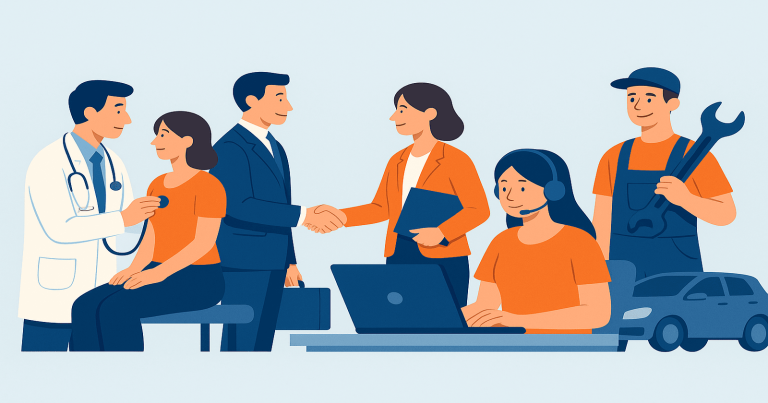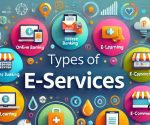A service is the action or activity that one person provides for another in return for money or some other consideration. Services exist to fulfill human needs and wants, solve problems, or assist operations in an intangible way. Services are valuable for life and within any economy. Unlike goods, which are tangible, and therefore can be stored, services are intangible and perishable. The production and consumption of services occur at the same time. A doctor examines and treats a patient; a teacher teaches a class; a courier delivers a parcel. In none of these cases is ownership transferred in the sense of ownership of a physical object; value is created by performing and executing these activities.
Meaning and Characteristics of Service
A service is any economic activity that does not result in the ownership of a physical item but offers value through performance. It is an action or effort done by one person or group for another, usually in exchange for money. The main goal of a service is to meet the needs or demands of a user without producing a tangible product.
Services have specific characteristics that make them different from goods. These traits affect how businesses deliver and manage services. Understanding these characteristics helps in managing customer expectations and improving service quality.
- Intangibility
Services cannot be touched, seen, or stored like products. Customers cannot inspect a service before buying it. Businesses must show value through outcomes, experiences, and trust. - Inseparability
Services are produced and consumed at the same time. A haircut or a live concert cannot happen in advance or be stored. This means service providers and users must interact during delivery. - Perishability
Services cannot be stored for future use. If a train seat goes empty or a hotel room is not booked, the opportunity to sell that service is lost forever. - Variability
The quality of a service may change depending on who provides it, where it is offered, or when it is used. This makes standardization difficult and requires training and consistency. - Customer Involvement
Services often need the presence and participation of the customer. In medical treatment or teaching, the user’s presence affects how the service is delivered and received.
These features show that services are interactive, real-time, and often personalized, making them unique in both delivery and management.

Types of Service — Based on Sector
Services work across different sectors of the economy, and each sector has a unique purpose and target audience. Classifying services by sector helps explain how they impact individuals, businesses, and society as a whole.
- Consumer Services
These are services directly offered to individuals for personal use, comfort, or convenience. Examples include restaurant dining, spa treatments, medical checkups, and tuition classes. Customer experience, satisfaction, and personalization are key success factors. These services are typically chosen based on price, reputation, and quality. - Business Services
These services help companies operate more efficiently and professionally. They include IT support, accounting, legal advisory, logistics, and human resource services. Organizations use these services to solve specific problems or meet regulatory requirements. These services often involve technical skills and are delivered under formal contracts. - Public or Government Services
These are essential services provided by the state for the welfare of the general public. Common examples are public transport, law enforcement, healthcare, and education. These services are usually funded by taxpayer money and not profit-driven. They are critical for economic stability, equality, and infrastructure development.
This classification shows how services serve personal, commercial, and societal needs and form the foundation of all modern systems.
Types of Service — Based on Delivery and Interaction
Services can also be classified based on how they are delivered and the type of customer involvement they require. This helps explain the level of human effort, automation, and communication used.
- Personal or Customized Services
These services need one-on-one contact between the provider and the customer. They are tailored to individual needs and preferences. Examples include medical care, legal advice, tutoring, and counseling. The provider’s skills and relationship with the client directly affect the service outcome. - Self-Service
Here, the customer completes the task using systems or tools provided by the business. Examples include ATMs, self-checkout counters, or online portals for ticket booking. These services reduce the need for staff, cut costs, and offer convenience. They work best when users are comfortable with technology. - Digital or Remote Services
These services are offered through digital platforms without physical contact. Examples include e-learning, telemedicine, online banking, and cloud storage. They allow scalability and access from anywhere. Service providers must ensure digital safety, data privacy, and technical support.
This delivery-based classification helps organizations design services that suit customer needs, cost targets, and technology levels.
Types of Service — Based on Industry
Each industry has its own service needs, and service types vary based on the field they support. This classification highlights how services enable sector-specific functions and operations.
- Financial Services
These services help people and businesses manage money, invest, and protect against risks. Examples are banking, insurance, stockbroking, and retirement planning. These services require regulation, transparency, and trust. They play a crucial role in economic development and personal security. - Hospitality and Tourism Services
These include services that offer comfort, entertainment, and accommodation. Examples are hotel stays, food delivery, travel planning, and resort services. Customer service and cleanliness are major success factors. These services contribute to cultural exchange and local job creation. - Educational Services
These services aim to build knowledge, skills, and character. They include schools, colleges, training centers, and online learning platforms. These services help in building human capital and national progress. Technology and accessibility are shaping the future of this sector. - Healthcare Services
These involve diagnosing, treating, and preventing illness. Hospitals, clinics, labs, and telemedicine platforms offer such services. Healthcare requires expertise, care, and ethical standards. It is a critical part of public welfare and quality of life.
This classification by industry shows how services form the backbone of key sectors and ensure progress, health, and education.
Difference Between Goods and Services
Understanding the difference between goods and services is important in business and economics. While both aim to satisfy needs, they differ in how they are created, delivered, and consumed.
- Goods are tangible and can be touched, seen, or stored, such as a car or mobile phone. Services are intangible and cannot be physically possessed. They exist only during delivery and experience.
- Goods can be produced, stored, and sold later, allowing inventory management. Services must be consumed as they are produced. A vacant hotel room or an unsold ticket cannot be sold again.
- Ownership transfers in goods transactions, giving full control to the buyer. Services do not transfer ownership but provide temporary use, benefit, or access.
- Goods quality can be checked before buying, while services are judged after use. Service quality depends on delivery, behavior, timing, and user satisfaction.
This difference explains why services need stronger focus on customer experience, training, and real-time management.
Importance of Services in Modern Economy
Services play a central role in today’s economy and daily life. They help individuals manage tasks, support businesses in operations, and assist governments in governance and public welfare.
- Services offer convenience and support in every part of life. From transportation and healthcare to communication and dining, they simplify daily routines and improve quality of life.
- Businesses rely on services like consulting, logistics, IT, and finance to run operations smoothly. These services bring technical expertise and efficiency that may not be available in-house.
- Public services maintain social order and infrastructure. Water supply, electricity, public schools, and emergency response are all essential for stability and development.
- Digital transformation has expanded services globally. Online shopping, cloud computing, virtual learning, and digital health now serve millions across borders, saving time and money.
- The service sector is a major source of employment, especially in urban economies. It offers roles in sales, customer care, software development, and more.
This importance highlights why investment in services leads to social, technological, and economic advancement.
Types of Service FAQs
Q1. What are the three main sectors in service classification?
The three sectors are consumer services, business services, and public or government services.
Q2. How are digital services different from personal services?
Digital services are delivered through technology and may not involve face-to-face contact. Personal services require direct interaction and human effort.
Q3. Why can’t services be stored like goods?
Services are produced and consumed at the same time. If not used when available, they are lost forever, making them perishable.
Q4. What makes business services different from consumer services?
Business services support company functions and are not sold to individuals. Consumer services are directly used by people for personal benefits.
Q5. What role do services play in the economy?
Services drive employment, support industries, improve lifestyle, and help governments serve the public better.


